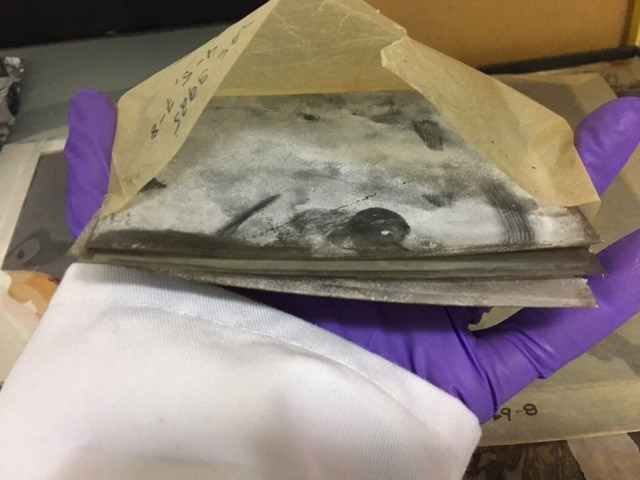Working from home is not the natural habitat of a conservator. Like many in the archive, we thrive when working with the collections. But while we have had to reduce our time at the bench, working from home has had some advantages. We researched solutions to new and historic conservation problems, continued our professional development, and planned future projects.
One of the most encouraging aspects of working from home has been the opportunity to collaborate and connect with our colleagues in the conservation sector from all over the world – none more so than during our Treatment Roundtable.
The Treatment Roundtable is a bi-monthly gathering where treatment conservators have the opportunity to discuss objects or collections requiring conservation and share the decision-making process with a community of peers. Conservators from The National Archives’ Collections Care department, as well as invited guests from other institutions, meet to discuss treatment approaches and talk about new developments in treatment practice. The gathering is open to conservators, conservation scientists, educators, curators and students, and over the past year it has developed into a successful international forum.
Last November, we invited colleagues from various institutions (including Getty Images Hulton Archive, Tate, Bodleian Libraries, Suffolk Archives, Wellcome Trust, Victoria & Albert Museum, Parliamentary Archives, BFI, University of Amsterdam, University of Lisbon and freelance photograph conservators from Barcelona) to take part in a session to discuss the issues of degrading film negatives in heritage collections, and different treatment and preservation approaches with their benefits and shortcomings. Emma Lowe, Photograph Conservator at Getty Images Hulton Archive, has written about her experience attending the session.

What might a collective noun for conservators be?
Dogs form a ‘pack’, baboons a ‘troop’, but perhaps appropriate for our profession would be the collective noun for wildebeest, an ‘improbability’?
It’s not that it’s unusual for us to get together and collaborate, it’s just that the nature of our species is to pose as many questions as we answer. Can we improve this treatment? Do we think X will work? What about Y? Are there any known disadvantages of Z? We are, after all, just custodians of the treasures we work on; if we get it right, they should outlive us and be around for generations. It’s a balance of probabilities. We tread carefully, constantly evaluating treatments and researching all the options.
But we are busy! So, forums like The National Archives’ Treatment Roundtable are invaluable, providing conservators a platform for rapid, shared learning, collating all our individual practices and experiences to address common conundrums. We thank you TNA. COVID-19 may have prevented our physical collective over the last year – a huge loss when dealing with treatments and materials – but the virtual sphere gave us a giant, cheap-as-chips-to-get-to table. Even more of us to metaphorically bang our heads together, more ideas, more experience and, dare I say it, a mute button.
Up for debate last time was the treatment of film negatives in our heritage collections. In other words, how do we deal with the nightmare that is our ageing nitrate negatives and films (1880s-1950s) and cellulose acetate (1909-present, although replaced with stable polyester since the mid 1950s)?

Deteriorating nitrates turn golden, the photographic emulsion ‘melts’ as the silver image oxidises, going soft and sticky before it turns into an acrid white powder. Acetate bubbles, then channels as the plasticiser exudes, may turn blue or pink depending on an anti-halation dye, becomes extremely brittle, cracks, disintegrating the emulsion. All characteristics which render the film impossible to read as objects/negatives. They also become extremely dangerous to people and collections, off-gassing toxic volatiles – nitrate releases a sweet smelling, highly flammable combination including Nitrate Oxide (NO), Nitrogen Dioxide (NO2), Nitrous Oxide (N2O) and Nitric Acid (HNO3), and acetate smells recognisably sharp, like salt and vinegar crisps (Acetic Acid (C2H4O2)! Dealing with these materials is no easy matter for conservators, curators, and collections managers alike.

The issues were presented and discussed across the disciplines, with ideas and advice given and received, from independent practitioners, conservation teams, private and public, from small collections holders to large institutions, museums, archives, and libraries, nationally and internationally. Another benefit of forums like the Treatment Roundtable is you get to meet fellow professionals – often the authors of the papers you read, the books you consult, but for sure the learned, the talented, the experienced and the future movers and shakers of conservation science. And the connections made seeking collective solutions for complex issues become strong bonds – not easily reversible, as we say in conservation.
There is always more to share, discover and evaluate, but virtual meetings are curtailed by the clock. Our allotted time was up and with a follow-up pencilled in the diary, our hosts threw us out. Maybe with an aperitif in hand our solutions on sub-zero storage, film-stripping, digitisation and physical surrogates would have been even more innovative? Highly probable? I look forward to the follow-up of the follow-up of the follow-up, and I thank everyone involved, particularly our hosts Barbara Borghese and Ioannis Vasallos, for the opportunity they afforded us.
Maybe the collective noun for owls – ‘a parliament’ – might be more appropriate. What do we all think?
If you are working in the conservation sector and want to find out more about our treatment roundtable, please contact us at consenquiries@nationalarchives.gov.uk.